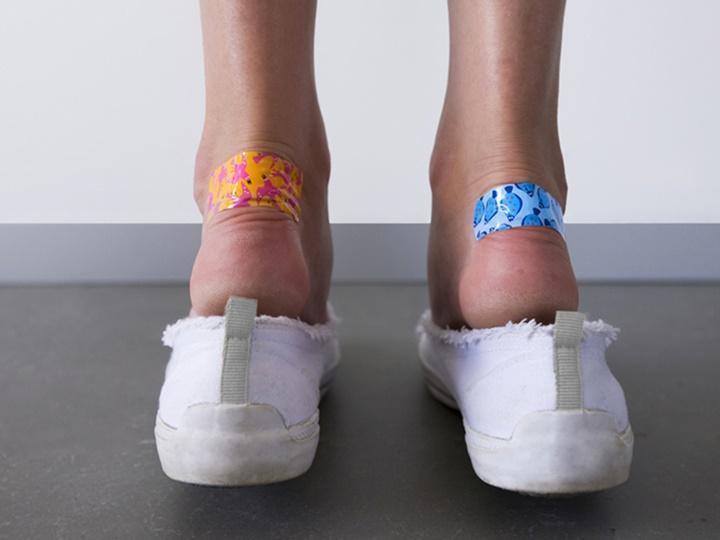We all know the pain of shoes that rub the back of your ankle. When you’re trying to walk from A to B, the last thing you want are shoes digging into the back of your foot and making life difficult. Walking should be easy and hassle free. Shoes should enable you to do this, not slow you down. Fortunately, there are a few simple steps you can take to help prevent this from happening and get you back on track.
You can stop shoes from rubbing the back of your ankle by 1) making sure you have the right size shoe, 2) using an insole to adjust the shoe’s fit, 3) stretching the heel of the shoe, 4) wearing thick or double socks, or 5) fixing the heel with a Moleskin pad.
Shoes rub the back of the ankle when they don’t fit snugly to the foot. The loose fit means that the shoe moves as you walk and this causes friction between the shoe and your ankle. This can result in blisters, bruises, cuts and scrapes which can make walking downright painful. The trick to solving this problem is to either stop the shoe from moving, or, if you can’t do that, protect the foot from the shoe’s movement. Here are some top tips on how to achieve this.
First, make sure you have the right size shoe for your foot. The number one cause of shoes that rub are shoes that are the wrong fit. They are either too big, too small, too narrow or too wide. Have your foot measured so you know the exact specifications, choose shoes that fit those specifications and always try the shoes on before you buy. Shoe sizes are general and often vary across different brands. Try walking in them and use your own feet to judge the fit. Know your size, know your feet.
Second, if you don’t want new shoes or have the right size shoes but they’re still rubbing, a great solution is to try wearing insoles. Insoles are inserted into the shoe to adjust the shoe’s dimensions from within. This can prevent the shoe from moving and rubbing the heel by bringing the foot to the shoe and making it fit snugly into place. This is a comfortable, easy and inexpensive way to solve the problem without buying a whole new pair of shoes.
Third, you can stretch the heel of the shoe. New shoes often rub because they haven’t yet molded to the shape of the foot. Once the shoes are repeatedly worn, the material adjusts itself to accommodate the shape of your foot.
It is when this doesn’t happen that you have a badly fitting shoe. In cases like this where the shoes don’t adjust on their own, you can try to stretch them yourself. A simple way to do this if you have leather shoes is to heat the heel of the shoe with a hairdryer. Once it’s heated, leave the shoe to cool for a few minutes and then slip it on over your foot. Your foot will stretch the malleable leather and it will begin to mold itself to the shape of your heel. Once this is done, you can repeat the process a few times until you’re happy with the feel.
Fourth, you can wear thick or double socks. So far, we have explored solutions that solve the problem by preventing the shoe from moving. If this doesn’t work, a quick fix is to wear thick or double socks as this can limit the damage to your foot.
The thick material protects the skin and bolsters the size of your foot so that the shoe is not so loose. This is an ideal technique if your shoe starts rubbing midway through a walk or the working day.
And fifth, a more long-term solution to protect your heel is to fix the heel of the shoe with a Moleskin pad. Moleskin is a soft, leathery material that will soften the shoe’s heel and prevent it from hurting.
You can glue it on with fabric glue or superglue, or alternatively sew it into place. This won’t necessarily stop the shoe from moving, but it will stop it from rubbing painfully on the back of the heel.
Frequently Asked Questions
How do I know if my shoes are a good fit?
You can tell if shoes are a good fit because if they are, you could forget that you’re wearing them. Well fitting shoes should hug to the foot effortlessly. There should be no discomfort, rubbing or pain.
How can I anticipate if my shoes will rub?
Most new shoes rub for the first few days as they are not yet molded to the feet. After they have been worn a few times, however, the rubbing stops as they adjust themselves to your feet. Shoes that rub are shoes that don’t adjust themselves, but continue rubbing. If your shoes keep rubbing after a week or two, then the likelihood is they are going to continue rubbing unless you take some action.
How can I stop shoes rubbing my toes?
Shoes rub the toes for much the same reason as they rub the heel. Ill fitting and loose shoes are the primary culprits. The movement of the shoe as you walk rubs against the toes, chafing and grazing them. In the case of toes, this is exacerbated if the interior of the shoe becomes sweaty and humid.
This can sometimes cause the sock to get wet and rub the skin along with the shoe. As the skin and socks are wet themselves, this makes them more susceptible to rubbing. If this is caused by long walks, this is to be expected and cannot always be avoided.
Thicker socks generally help prevent it, as does removing the shoes every few hours to air them out. Alternatively, if the rubbing is a more chronic problem, the best solution is to look for new shoes or invest in an insole.

